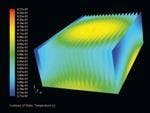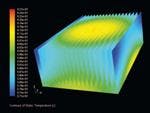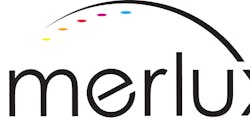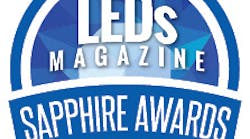This article was published in the April 2013 issue of LEDs Magazine.
View the Table of Contents and download the PDF file of the complete April 2013 issue, or view the E-zine version in your browser.
+++++
With LED-based solid-state lighting (SSL) technology revolutionizing the lighting industry, new opportunities for lighting products are appearing everywhere from residential to commercial to street lights. However, the dirty little secret of LED technology is that it presents a thermal management challenge that is significantly different, and hotter, than any challenge ever presented by legacy light bulbs. Conducting heat away from the LED junctions is a requisite for long product life and consistent lumen and color maintenance. There are many material and manufacturing choices for thermal management, and aluminum extrusions can serve in a broad set of applications.
Architects, lighting designers, and other specifiers are demanding fixtures and enclosures that offer great looks, options for both finish and color, as well as structural integrity. Design engineers are attempting to provide the above, while dealing with the thermal management issue. Lighting manufacturers want to deliver all of the above, but in cost-effective products.
The thermal challenge
The objective of thermal engineers is to remove the heat from the source and dissipate it into the surrounding atmosphere, as far from the electronics and as fast as possible. The lighting industry prefers to use passive thermal-management products such as heat sinks as opposed to active thermal-management techniques. Typically, active thermal management equates to the addition of a device to assist in moving air over the heat sink, often a fan. Moving air can increase the effectiveness of a heat sink or even enable the use of a smaller heat sink in some applications. However, active elements can increase cost, add noise, and/or decrease system reliability.
Engineers typically use the light-fixture or enclosure materials to assist in transferring the heat. Most materials have the ability to conduct heat, some better than others. This ability is also referred to as thermal conductivity and is measured in watts per meter kelvin (W/mk).
Different materials offer a broad range of thermal conductivity. For example, diamonds have a very high level (typically 2200 W/mK), but are obviously too expensive for use in lighting applications. Copper has a decent level of thermal conductivity (typically 390 W/mK), but has two significant drawbacks compared to aluminum — copper weighs approximately three times more than aluminum and typically costs up to five times as much. Aluminum doesn’t conduct heat quite as well (237 W/mk maximum), but offers the weight and cost advantages that are important in many SSL applications.
Computational fluid dynamics
To assist in determining the proper thermal management solution, engineers typically work with specialized software that models the products and their thermal characteristics. Computational fluid dynamics (CFD) is used to simulate the thermal conductivity of the product and finite element analysis (FEA) examines the structural integrity of the component. An example of CFD is shown in Fig. 1. There are numerous variables in each product that are dependent on product size, shape, and application (indoor versus outdoor, for example). By combining FEA and CFD along with the variables, it is possible to design the most cost-effective product that meets the needs of both the design engineer and thermal engineer.
Through the remainder of this article, we will review the four materials and manufacturing process combinations that are most often utilized to address the thermal management challenge in LED fixtures. The candidates are:
-Aluminum extrusions,
-Aluminum castings,
-Injection-molded thermo-plastics, and
-Molded graphite.
There are certain designs, applications, or conditions where each one of these materials/processes makes sense.
Extrusions vs. castings
Aluminum extrusions and aluminum castings are most often used in LED thermal management. Sapa alone provided millions of pounds of extrusions to the lighting industry in 2012. That growth is being driven by improving thermal efficiency, design flexibility, and the cost advantages of aluminum extrusions versus castings, proof that many designers are discovering that aluminum castings are not the solution for the majority of the applications.
There are several types of castings used in the lighting industry. For lower volume applications, such as specialized street lights, sand castings are the product of choice. Other types of castings include permanent-mold castings, which are used for mid-volume applications, such as standard industrial or warehouse lighting applications. Finally, die castings are used for high-volume applications, such as lights sold through retailers.
When considering the associated costs, sand castings have the lowest tooling costs, which typically fall within the $5,000 to $10,000 range and offer the highest piece price. Pricing for permanent mold castings typically ranges from $15,000 to $30,000. Piece part pricing for both sand and permanent mold products are highly dependent on the amount of secondary machining required.
Die castings have lower piece prices compared to both sand and permanent-mold castings and usually require the least amount of secondary operations, however tooling can range from $50,000 to $100,000. Injection-molded tooling costs are similar to those of die-casting tooling.
All forms of aluminum cast tooling have a specified life expectancy after which tooling needs to be replaced. By comparison, tooling for a large extrusion generally falls within the $5,000 to $7,500 range, and aluminum extruders typically cover all replacement tooling costs, giving extrusions a cost advantage over castings.
Thermal conductivity
In terms of thermal conductivity, there is a clear advantage to using extrusions over castings. Aluminum extrusions can be 53% more efficient than castings because they contain a higher level of thermal conductivity. The collective conductivity of the types of castings referenced above is typically within the 120–140-W/mK range, while the conductivity of aluminum extrusions is typically within a much higher 200–215-W/mK range. Fig. 2 shows the comparative thermal conductivities of pure aluminum, extruded alloys, and cast alloys.
Numerous lighting companies have found out the hard way that sand, mold, and die castings can be less efficient than aluminum extrusions. The nature of the casting process creates problems with gas porosity. If the porosity is near the area generating the heat, the porosity acts as an oven, holding the heat in that area, which will then reduce the life of the LED. This is especially a problem with foreign casters who may have lower quality procedures and standards. Porosity is not an issue with the aluminum extrusion process.
The increase in thermal conductivity of extrusions versus castings allows the lighting manufacturer to use less material to obtain the same thermal efficiency. Less material plus a smaller footprint usually equates to lower total costs. Additionally, high-volume CNC machining allows extruders to machine in features in a cost-effective manner. Another design advantage to extrusions is that the process allows for a superior surface finish, which can be anodized in numerous colors, bright-dipped, or painted any color (Fig. 4).
With extrusions, there is also more flexibility in terms of size. Extruders can create products upwards of 21-inches wide and offer fin ratios of 19:1. Two methods of providing wider products include a snap-fit design, which is often used for enclosures or boxes, and a technology called friction stir welding, which allows extruders to join two or more pieces of aluminum together with no filler material. Sapa has used this technology to hermetically seal an extrusion by welding a cover on the top, which can be particularly useful in industrial lighting applications where the fixtures need to be explosion resistant.
Injection-molded thermo-plastics and graphite
There are some situations in which aluminum castings, and injection-molded thermo-plastics or graphite do have advantages over extrusions. Typically, they are small applications where the heat sinks need to be attached to the bulb, often in the case of retrofitting legacy products. Although an extrusion could provide a better thermal management solution, the machining to create the contour is slightly more expensive than the as-cast/molded product.
An optimum LED enclosure design should be developed with the help of engineers that specialize in thermal and quality disciplines. Extrusion engineers can provide in-depth thermal analysis and also design an extrusion to simplify the manufacturing process. This allows for working directly with the manufacturer, from design to finishing, for a customized approach to thermal management that exactly matches application requirements.









